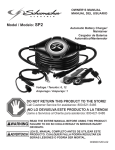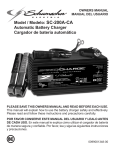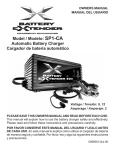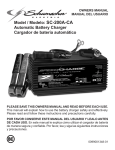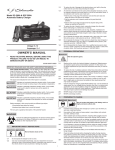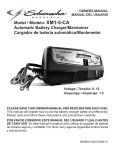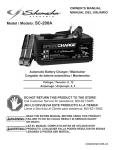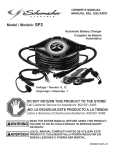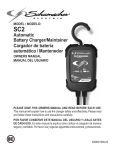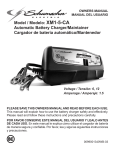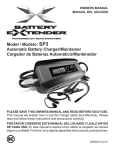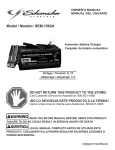Download Schumacher SP3 Owner`s manual
Transcript
OWNER’S MANUAL MANUAL DEL USUARIO Model / Modelo: SP3 Automatic Battery Charger/Maintainer Cargador de Baterías Automático/Mantenedor Voltage / Tensión: 6, 12 Amperage/ Amperaje: 3 DO NOT RETURN THIS PRODUCT TO THE STORE! Call Customer Service for assistance: 800-621-5485 ¡NO LO DEVUELVA ESTE PRODUCTO A LA TIENDA! Llame a Servicios al Cliente para asistencia: 800-621-5485 READ THE ENTIRE MANUAL BEFORE USING THIS PRODUCT. FAILURE TO DO SO COULD RESULT IN SERIOUS INJURY OR DEATH. LEA EL MANUAL COMPLETO ANTES DE UTILIZAR ESTE PRODUCTO. CUALQUIER FALLA PODRÍA RESULTAR EN SERIAS LESIONES O PODRÍA SER MORTAL. 0099001289-01 IMPORTANT:READ AND SAVE THIS SAFETY AND INSTRUCTION MANUAL. SAVE THESE INSTRUCTIONS – This manual will show you how to use your charger/maintainer safely and effectively. Please read, understand and follow these instructions and precautions carefully, as this manual contains important safety and operating instructions. The safety messages used throughout this manual contain a signal word, a message and an icon. The signal word indicates the level of the hazard in a situation. Indicates an imminently hazardous situation which, if not avoided, will result in death or serious injury to the operator or bystanders. Indicates a potentially hazardous situation which, if not avoided, could result in death or serious injury to the operator or bystanders. Indicates a potentially hazardous situation which, if not avoided, could result in moderate or minor injury to the operator or bystanders. Indicates a potentially hazardous situation which, if not avoided, could result in damage to the equipment or vehicle or property damage. Pursuant to California Proposition 65, this product contains chemicals known to the State of California to cause cancer and birth defects or other reproductive harm. Wash hands after handling. 1. IMPORTANT SAFETY INSTRUCTIONS – SAVE THESE INSTRUCTIONS. This manual contains important safety and operating instructions. RISK OF ELECTRIC SHOCK OR FIRE. 1.1 Keep out of reach of children. 1.2 Do not expose the charger to rain or snow. •2• 1.3 Use only recommended attachments. Use of an attachment not recommended or sold by the battery charger manufacturer may result in a risk of fire, electric shock or injury to persons or damage to property. 1.4 To reduce the risk of damage to the electric plug or cord, pull by the plug rather than the cord when disconnecting the charger. 1.5 An extension cord should not be used unless absolutely necessary. Use of an improper extension cord could result in a risk of fire and electric shock. If an extension cord must be used, make sure: • That the pins on the plug of the extension cord are the same number, size and shape as those of the plug on the charger. • That the extension cord is properly wired and in good electrical condition. • That the wire size is large enough for the AC ampere rating of the charger as specified in section 8. 1.6 To reduce the risk of electric shock, unplug the charger from the outlet before attempting any maintenance or cleaning. Simply turning off the controls will not reduce this risk. 1.7 Do not operate the charger with a damaged cord or plug; have the cord or plug replaced immediately by a qualified service person. 1.8 Do not operate the charger if it has received a sharp blow, been dropped or otherwise damaged in any way; take it to a qualified service person. 1.9 Do not disassemble the charger; take it to a qualified service person when service or repair is required. Incorrect reassembly may result in a risk of fire or electric shock. RISK OF EXPLOSIVE GASES. 1.10 WORKING IN THE VICINITY OF A LEAD-ACID BATTERY IS DANGEROUS. BATTERIES GENERATE EXPLOSIVE GASES DURING NORMAL BATTERY OPERATION. FOR THIS REASON, IT IS OF UTMOST IMPORTANCE THAT YOU FOLLOW THE INSTRUCTIONS EACH TIME YOU USE THE CHARGER. 1.11 To reduce the risk of a battery explosion, follow these instructions and those published by the battery manufacturer and the manufacturer of any equipment you intend to use in the vicinity •3• of the battery. Review the cautionary markings on these products and on the engine. 1.12 This charger employs parts, such as relays and circuit breakers, that tend to produce arcs and sparks. If used in a garage, locate this charger 18 inches or more above floor level. 2. PERSONAL PRECAUTIONS RISK OF EXPLOSIVE GASES. 2.1 NEVER smoke or allow a spark or flame in the vicinity of a battery or engine. 2.2 Remove personal metal items such as rings, bracelets, necklaces and watches when working with a leadacid battery. A lead-acid battery can produce a short-circuit current high enough to weld a ring or the like to metal, causing a severe burn. 2.3 Be extra cautious, to reduce the risk of dropping a metal tool onto the battery. It might spark or short-circuit the battery or other electrical part that may cause an explosion. 2.4 Use this charger for charging LEAD-ACID and AGM batteries only. It is not intended to supply power to a low voltage electrical system other than in a starter-motor application. Do not use this battery charger for charging dry-cell batteries that are commonly used with home appliances. These batteries may burst and cause injury to persons and damage to property. 2.5 NEVER charge a frozen battery. 2.6 Consider having someone nearby to come to your aid when you work near a lead-acid battery. 2.7 Have plenty of fresh water and soap nearby in case battery acid contacts your skin, clothing or eyes. 2.8 Wear complete eye and body protection, including safety goggles and protective clothing. Avoid touching your eyes while working near the battery. 2.9 If battery acid contacts your skin or clothing, immediately wash the area with soap and water. If acid enters your eye, immediately flood the eye with cold running water for at least 10 minutes and get medical attention right away. 2.10 If battery acid is accidentally swallowed, drink milk, the whites of eggs or water. DO NOT induce vomiting. Seek medical attention immediately. •4• 3. PREPARING TO CHARGE RISK OF CONTACT WITH BATTERY ACID. BATTERY ACID IS A HIGHLY CORROSIVE SULFURIC ACID. 3.1 If it is necessary to remove the battery from the vehicle to charge it, always remove the grounded terminal first. Make sure all of the accessories in the vehicle are off to prevent arcing. 3.2 Be sure the area around the battery is well ventilated while the battery is being charged. 3.3 Clean the battery terminals before charging the battery. During cleaning, keep airborne corrosion from coming into contact with your eyes, nose and mouth. Use baking soda and water to neutralize the battery acid and help eliminate airborne corrosion. Do not touch your eyes, nose or mouth. 3.4 Add distilled water to each cell until the battery acid reaches the level specified by the battery manufacturer. Do not overfill. For a battery without removable cell caps, such as valve regulated lead acid batteries (VRLA), carefully follow the manufacturer’s recharging instructions. 3.5 Read, understand and follow all instructions for the charger, battery, vehicle and any equipment used near the battery and charger. Study all of the battery manufacturer’s specific precautions while charging and recommended rates of charge. 3.6 Determine the voltage of the battery by referring to the vehicle owner’s manual. 3.7 Make sure that the charger cable clips make tight connections. 4. CHARGER LOCATION RISK OF EXPLOSION AND CONTACT WITH BATTERY ACID. 4.1 Locate the charger as far away from the battery as the DC cables permit. 4.2 Never place the charger directly above the battery being charged; gases from the battery will corrode and damage the charger. •5• 4.3 Do not set the battery on top of the charger. 4.4 Never allow battery acid to drip onto the charger when reading the electrolyte specific gravity or filling the battery. 4.5 Do not operate the charger in a closed-in area or restrict the ventilation in any way. 5. DC CONNECTION PRECAUTIONS 5.1 Connect and disconnect the DC output clips only after removing the AC plug from the electrical outlet. 5.2 Attach the clips to the battery and chassis, as indicated in sections 6 and 7. 6. FOLLOW THESE STEPS WHEN BATTERY IS INSTALLED IN VEHICLE. A SPARK NEAR THE BATTERY MAY CAUSE A BATTERY EXPLOSION. TO REDUCE THE RISK OF A SPARK NEAR THE BATTERY: 6.1 Position the AC and DC cables to reduce the risk of damage by the hood, door and moving or hot engine parts. NOTE: If it is necessary to close the hood during the charging process, ensure that the hood does not touch the metal part of the battery clips or cut the insulation of the cables. 6.2 Stay clear of fan blades, belts, pulleys and other parts that can cause injury. 6.3 Check the polarity of the battery posts. The POSITIVE (POS, P, +) battery post usually has a larger diameter than the NEGATIVE (NEG, N, -) post. 6.4 Determine which post of the battery is grounded (connected) to the chassis. If the negative post is grounded to the chassis (as in most vehicles), see step 6.5. If the positive post is grounded to the chassis, see step 6.6. 6.5 For a negative-grounded vehicle, connect the POSITIVE (RED) clip from the battery charger to the POSITIVE (POS, P, +) ungrounded post of the battery. Connect the NEGATIVE (BLACK) clip to the vehicle chassis or engine block away from the battery. Do not connect the clip to the carburetor, fuel lines or sheet-metal •6• body parts. Connect to a heavy gauge metal part of the frame or engine block. 6.6 For a positive-grounded vehicle, connect the NEGATIVE (BLACK) clip from the battery charger to the NEGATIVE (NEG, N, -) ungrounded post of the battery. Connect the POSITIVE (RED) clip to the vehicle chassis or engine block away from the battery. Do not connect the clip to the carburetor, fuel lines or sheet-metal body parts. Connect to a heavy gauge metal part of the frame or engine block. 6.7 Connect the charger AC supply cord to electrical outlet. 6.8 When disconnecting the charger, disconnect the AC cord, remove the clip from the vehicle chassis and then remove the clip from the battery terminal. 7. FOLLOW THESE STEPS WHEN BATTERY IS OUTSIDE THE VEHICLE. A SPARK NEAR THE BATTERY MAY CAUSE A BATTERY EXPLOSION. TO REDUCE THE RISK OF A SPARK NEAR THE BATTERY: 7.1 Check the polarity of the battery posts. The POSITIVE (POS, P, +) battery post usually has a larger diameter than the NEGATIVE (NEG, N, -) post. 7.2 Attach at least a 24-inch (61 cm) long 6-gauge (AWG) (13.29 mm2) insulated battery cable to the NEGATIVE (NEG, N, -) battery post. 7.3 Connect the POSITIVE (RED) charger clip to the POSITIVE (POS, P, +) post of the battery. 7.4 Position yourself and the free end of the cable you previously attached to the NEGATIVE (NEG, N, -) battery post as far away from the battery as possible – then connect the NEGATIVE (BLACK) charger clip to the free end of the cable. 7.5 Do not face the battery when making the final connection. 7.6 Connect charger AC supply cord to electrical outlet. 7.7 When disconnecting the charger, always do so in the reverse order of the connecting procedure and break the first connection while as far away from the battery as practical. •7• 7.8 A marine (boat) battery must be removed and charged on shore. To charge it onboard requires equipment specially designed for marine use. 8. GROUNDING AND AC POWER CORD CONNECTIONS RISK OF ELECTRIC SHOCK OR FIRE. 8.1 This battery charger is for use on a nominal 120-volt circuit. The plug must be plugged into an outlet that is properly installed and grounded in accordance with all local codes and ordinances. The plug pins must fit the receptacle (outlet). Do not use with an ungrounded system. 8.2 Never alter the AC cord or plug provided – if it does not fit the outlet, have a proper grounded outlet installed by a qualified electrician. An improper connection can result in a risk of an electric shock or electrocution. NOTE: Pursuant to Canadian Regulations, use of an adapter plug is not allowed in Canada. Use of an adapter plug in the United States is not recommended and should not be used. 8.3 Recommended minimum AWG size for extension cord: • 100 feet (30.5 meters) long or less – use an 18 gauge (0.82 mm2) extension cord. • Over 100 feet (30.5 meters) long – use a 16 gauge (1.31 mm2) extension cord. 9. ASSEMBLY INSTRUCTIONS Remove all cord wraps and uncoil the cables prior to using the battery charger. •8• 10. FEATURES/CONTROL PANEL 1 1. Battery Status LEDs 2. AC Power cord 3. Quick-Connect Battery Clamp Cable Assembly 4. Quick-Connect Cable with Fuse 5. Cord Set w/12V Cigarette Adapter 2 4 5 3 10.1 Digital Display The digital display gives a digital indication of the status of the battery and charger. See the TROUBLESHOOTING section for a complete list of messages. 10.2 LED Display CHARGING (yellow) LED lit: Indicates the charger is charging the battery. CHARGED (green) LED lit: Indicates the battery is fully charged and the charger is in maintain mode. 11. OPERATING INSTRUCTIONS This battery charger must be properly assembled in accordance with the assembly instructions before it is used. The charger does not have an ON/OFF switch. Plug the SP3 into a 120V AC electrical wall outlet only after battery connections have been made. NOTE: This charger is equipped with an auto-start feature. It will not supply current to the battery clips until a battery is properly connected. The clips will not spark if touched together. •9• Charging 1. Ensure that all of the charger components are in place and in good working condition, for example, the plastic boots on the battery clips. 2. Connect the battery following the connection instructions described in Using the Quick-Connect Cable Connectors section. 3. Connect the AC power following the precautions listed in section 8. 4. When the charger starts, the display will show “ANALYZING BATTERY” while the charger determines if the battery is properly connected, the condition of the battery and whether it is a 6 volt or 12 volt battery. If everything is good, the charger will start charging; the CHARGING (yellow) LED will be lit and the display will show “CHARGING 12V (or 6V) and the Battery Percentage of Charge”. If the charger determines there is a problem, the display will show what the problem is. Either correct the problem or have the battery checked/replaced. Using the Quick-Connect Cable Connectors Connect any of the three output cable assemblies to the charger in a matter of seconds. Make sure to place the charger on a dry, non-flammable surface. Never connect the clamp and ring terminal connectors together for use in other applications, such as external battery or other power source charging, or to extend the output cable length, as reverse polarity and/or overcharge conditions will occur. 50 Amp Battery Clips 1. Connect the end of the charger output cable to the end of the 50 Amp Battery clips cable. 2. Follow the steps in sections 6 and 7 to connect the output clips to the battery. 3. After a good electrical connection is made to the battery, plug the power cord into a grounded 120V AC electrical wall outlet. Quick-Connect Cable with Fuse The ring connectors permanently attach to the battery, providing easy access to quickly connect the charger to your battery. This application is appropriate for motorcycles, lawn tractors, ATVs and snowmobiles. • 10 • 1. To permanently attach to a battery, loosen and remove each nut from the bolt at the battery terminal. 2. Connect the red POSITIVE connector ring to the POSITIVE battery terminal. 3. Connect the black NEGATIVE connector ring to the NEGATIVE battery terminal. 4. Replace and tighten the nuts to secure. 5. Connect the cable to the end of the charger output cord. Take care to keep the wires and plug away from metal and moving parts. 6. Plug the charger power cord into a grounded 120V AC electrical wall outlet. Cord Set with 12V Cigarette Adapter Charge or maintain your battery without lifting the hood. 1. Connect the end of the Cord Set with 12V Cigarette Adapter to the charger. 2. Insert the 12V accessory plug into the 12V accessory outlet. 3. Route the power cord from the charger through the vehicle’s open window. 4. Plug the charger power cord into a grounded 120V AC electrical wall outlet. 5. If the vehicle’s ignition key has to be on in order for the accessory outlet to supply/receive power, turn the key on. Battery Connection Indicator If the charger does not detect a properly connected battery, charging will not start and the digital display will show one of two messages. If the display shows “CONNECT CLAMPS”, make sure the charger is connected to the battery and the connection points are clean and making a good connection. If the display shows “WARNING CLAMPS REVERSED”, unplug the charger from the AC outlet and reverse the connections at the battery. Charge Completion and Maintain Mode (Float-Mode Monitoring) Charge completion is indicated by the CHARGED (green) LED turning on and the digital display showing “FULLY CHARGED AUTO MAINTAINING”. This means that the charger has stopped charging and has switched to the Maintain Mode of operation. • 11 • NOTE: If the charger has to provide its maximum maintain current for a continuous 12 hour period, it will go into Abort Mode (see Aborted Charge section). This is usually caused by a drain on the battery, or the battery could be bad. Make sure there are no loads on the battery. If there are, remove them. If there are none, have the battery checked or replaced. Maintaining a Battery The SP3 is a battery charger/maintainer that maintains both 6 and 12 volt batteries, keeping them at full charge. It can charge small batteries and maintain both small and large batteries. If you are maintaining a fully charged large battery, you are properly utilizing the battery charger. However, if you were to use this battery charger to charge a large battery, such as a marine deep cycle battery, that was not fully charged, you may lose some of the battery’s capacity. This would cause the large battery to be unable to hold a charge and become useless. Therefore, we do not recommend charging a large battery with this unit. NOTE: The maintain mode technology utilized in Schumacher chargers allows you to safely charge and maintain a healthy battery for extended periods of time. However, problems with the battery, electrical problems in the vehicle, improper connections or other unanticipated conditions could cause excessive current draws. As such, occasionally monitoring your battery and the charging process is recommended. Desulfation Mode If the battery is left discharged for an extended period of time, it could become sulfated and not accept a normal charge. If the charger detects a sulfated battery, the charger will switch to a special mode of operation designed for such batteries. If successful, normal charging will resume after the battery is desulfated. Desulfation could take up to 8 hours. If desulfation fails, charging will abort, the yellow LED will blink, and the display will show “CHARGING ABORTED BAD BATTERY”. Aborted Charge If charging cannot be completed normally, charging will abort. When charging aborts, the charger’s output is shut off, the yellow LED will blink, and the display will show “CHARGING ABORTED BAD BATTERY”. To reset after an aborted charge, unplug the charger from the outlet, wait a few moments and plug it back in. • 12 • 12. DISPLAY MESSAGES CONNECT CLAMPS (No LED lit) – Plugged into the AC outlet without the clamps connected to a battery. WARNING CLAMPS REVERSED (no LED lit) – Plugged into the AC outlet and the clamps are connected backwards to a 6V or 12V battery. ANALYZING BATTERY (No LED lit) – Plugged into the AC outlet, and when first connected to a 6V or 12V battery correctly. CHARGING 12V – XX% (Yellow LED lit) – Plugged into the AC outlet and correctly connected to a discharged 12V battery. CHARGING 6V – XX% (Yellow LED lit) – Plugged into the AC outlet and correctly connected to a discharged 6V battery. FULLY CHARGED AUTO MAINTAINING (Green LED lit) – Plugged into the AC outlet and correctly connected to a fully charged 6V or 12V battery. CHARGING ABORTED BAD BATTERY (Yellow LED blinking) 13. MAINTENANCE INSTRUCTIONS 13.1 After use and before performing maintenance, unplug and disconnect the battery charger (see sections 6, 7 and 8). 13.2 Use a dry cloth to wipe all battery corrosion and other dirt or oil from the terminals, cords and the charger case. 13.3 Ensure that all of the charger components are in place and in good working condition, including the plastic boots on the battery clips. 13.4 Servicing does not require opening the unit, as there are no user-serviceable parts. 13.5 All other servicing should be performed by qualified service personnel. 14. MOVING AND STORAGE INSTRUCTIONS 14.1 Store the charger unplugged, in an upright position. The AC cord will still conduct electricity until it is unplugged from the outlet. 14.2 Store inside, in a dry, cool place. 14.3 Do not store the clips on or around metal, clipped together or clipped to cables. 14.4 If the charger is moved around the shop or transported to another location, take care to avoid/prevent damage to the cords, clips and charger. Failure to do so could result in personal injury or property damage. • 13 • 15. TROUBLESHOOTING PROBLEM Yellow LED is blinking and display shows CHARGE ABORTED–BAD BATTERY. POSSIBLE CAUSE REASON/SOLUTION The battery is sulfated. Reset the charger by briefly unplugging it. The battery is too large for the charger. You need a charger with a higher AMP rate. The display shows Clamps are not CONNECT CLAMPS. making a good connection. The fuse is bad. Check for poor connection at battery and frame. Replace the in-line fuse for the ring connector. 16. REPLACEMENT PARTS Cable Battery Assembly...............................................3899002636 Quick-Connect Cable with Fuse ..................................2299002042 Cord Set with 12V Cigarette Adapter...........................3899001401 17. BEFORE RETURNING FOR REPAIRS 17.1 When an UNKNOWN OPERATING PROBLEM arises, please read the complete manual and call the customer service number for information. This will usually eliminate the need for return. If the above solutions do not eliminate the problem, or for information about troubleshooting or replacement parts, call toll-free from anywhere in the U.S.A. 1-800-621-5485 7:00 am to 5:00 pm Central Time, Monday through Friday For REPAIR OR RETURN, contact Customer Service at 1-800-621-5485. DO NOT SHIP UNIT until you receive RETURN AUTHORIZATION from Customer Service at Schumacher Electric Corporation. • 14 • 18. LIMITED WARRANTY WARRANTY NOT VALID IN MEXICO. SCHUMACHER ELECTRIC CORPORATION, 801 BUSINESS CENTER DRIVE, MOUNT PROSPECT, IL 60056-2179, MAKES THIS LIMITED WARRANTY TO THE ORIGINAL RETAIL PURCHASER OF THIS PRODUCT. THIS LIMITED WARRANTY IS NOT TRANSFERABLE OR ASSIGNABLE. Schumacher Electric Corporation (the “Manufacturer”) warrants this battery charger for 5 years from the date of purchase at retail against defective material or workmanship that may occur under normal use and care. If your unit is not free from defective material or workmanship, Manufacturer’s obligation under this warranty is solely to repair or replace your product with a new or reconditioned unit at the option of the Manufacturer. It is the obligation of the purchaser to forward the unit, along with proof of purchase and mailing charges prepaid to the Manufacturer or its authorized representatives in order for repair or replacement to occur. Manufacturer does not provide any warranty for any accessories used with this product that are not manufactured by Schumacher Electric Corporation and approved for use with this product. This Limited Warranty is void if the product is misused, subjected to careless handling, repaired, or modified by anyone other than Manufacturer or if this unit is resold through an unauthorized retailer. Manufacturer makes no other warranties, including, but not limited to, express, implied or statutory warranties, including without limitation, any implied warranty of merchantability or implied warranty of fitness for a particular purpose. Further, Manufacturer shall not be liable for any incidental, special or consequential damage claims incurred by purchasers, users or others associated with this product, including, but not limited to, lost profits, revenues, anticipated sales, business opportunities, goodwill, business interruption and any other injury or damage. Any and all such warranties, other than the limited warranty included herein, are hereby expressly disclaimed and excluded. Some states do not allow the exclusion or limitation of incidental or consequential damages or length of implied warranty, so the above limitations or exclusions may not apply to you. This warranty gives you specific legal rights and it is possible you may have other rights which vary from this warranty. • 15 • THIS LIMITED WARRANTY IS THE ONLY EXPRESS LIMITED WARRANTY AND THE MANUFACTURER NEITHER ASSUMES OR AUTHORIZES ANYONE TO ASSUME OR MAKE ANY OTHER OBLIGATION TOWARDS THE PRODUCT OTHER THAN THIS WARRANTY. Schumacher Electric Corporation Customer Service 1-800-621-5485 Monday-Friday 7:00 a.m. to 5:00 p.m. CST Schumacher® and the Schumacher Logo are registered trademarks of Schumacher Electric Corporation. DO NOT RETURN THIS PRODUCT TO THE STORE! Call Customer Service for assistance: 800-621-5485 • 16 • • 17 • For faster warranty activation, go to www.batterychargers.com to register your product online. MODEL:______________________ DESCRIPTION:_________________________ This is the only express limited warranty, and the manufacturer neither assumes nor authorizes anyone to assume or make any other obligation. There is no other warranty, other than what is described in the product owner’s manual. The warranty card should be submitted within 30 days of purchase. The customer must keep the ORIGINAL receipt because it will be required for any warranty claims. This warranty is not transferable. Send warranty card only. DO NOT SEND UNIT TO THIS ADDRESS FOR REPAIR. Mail this card to: Schumacher Electric Corporation 801 Business Center Drive Mount Prospect, IL 60056-2179 Name_______________________________________________________________ Street Address________________________________________________________ City_________________________________ State__________ Zip Code__________ Phone______________________ Email____________________________________ Store Name Where Purchased____________________ Date of Purchase__________ Store Location_____________________ UPC Number_________________________ Serial Number_______________________________________ (SEE PRODUCT) 5 YEAR LIMITED WARRANTY PROGRAM REGISTRATION SAVE ON POSTAGE! ACTIVATE YOUR WARRANTY ONLINE – THE QUICK AND EASY WAY! Go to www.batterychargers.com to register your product online. (No internet access? Send in the completed warranty card.) • 18 • Para una activación más rápida, visite nuestra página de internet en www.batterychargers.com MODELO:_____________________ DESCRIPTIÓN:_________________________ Esta es la única garantía limitada expresa, y el productor no autoriza ni otorga a alguien a realizar alguna otra obligación. No existe ninguna otra garantía más que la descrita en el manual del dueño. La tarjeta de garantía debe enviarse durante los primeros 30 días después de la compra. El cliente debe mantener el recibo de compra ORIGINAL como comprobante, el cual le otorga todo derecho a cualquier reclamo de garantía. Esta garantía no es transferible. Envie tarjeta de garantía solamente. NO ENVÍE LA UNIDAD A ESTA DIRECCIÓN PARA SU REPARACIÓN. Enviar esta tarjeta a: Schumacher Electric Corporation 801 Business Center Drive Mount Prospect, IL 60056-2179 Nombre_____________________________________________________________ Dirección____________________________________________________________ Ciudad___________________________Estado_____________ C.P.______________ Tel:_________________________ Correo electrónico__________________________ Nombre de la Tienda donde se Compró_____________ Fecha de compra__________ Localización de la Tienda_____________ Numero de Serie_____________________ Código de barras____________________________ (CONSULTE EL PRODUCTO) PROGRAMA DE REGISTRO DE 5-AÑOS DE GARANTÍA LIMITADA ¡AHORRE EN EL ENVÍO! ¡ACTIVE SU GARANTÍA EN LÍNEA – LA FORMA MAS RÁPIDA Y FÁCIL! Visite nuestra página en www.batterychargers.com para registrar su producto en línea. (¿No tiene acceso al internet? Llene la tarjeta de garantía y envíela.) IMPORTANTE: LEA Y GUARDE ESTE MANUAL DE INSTRUCCIONES Y SEGURIDAD. GUARDE ESTAS INSTRUCCIONES – Este manual le mostrará cómo utilizar su cargador/mantenedor en forma segura y efectiva. Por favor, lea, comprenda y siga estas instrucciones y precauciones cuidadosamente, ya que este manual contiene instrucciones operativas y de seguridad de importancia. Los mensajes de seguridad representados en este manual contienen palabras guía, un mensaje y una figura. La palabra guía indica el nivel de peligro en determinada situación. Indica una inminente situación de riesgo que, si no se evita, resultaría mortal o de serios perjuicios al operador o personas alrededor. Indica una situación potencialmente riesgoso que, si no se evita, podría resultar o de serios perjuicios al operador o personas alrededor. Indica una situación potencialmente peligrosa que, de no evitarse, podría resultar en menores o serio daños al usuario y terceras personas. Indica una situación potencialmente peligrosa que, de no evitarse, podría causar daño al equipo, al vehículo y propiedades alrededor. Conforme a la propuesta 65 de California, este producto contiene químicos de los cuales en el Estado de California se tiene conocimiento que provocan cáncer y malformaciones congénitas u otras lesiones reproductivas. Lávese las manos después de usar. 1. INSTRUCCIONES IMPORTANTES DE SEGURIDAD – GUARDE ESTAS INSTRUCCIONES. Este manual contiene instrucciones operativas y de seguridad de importancia. EL RIESGO DE DESCARGA ELÉCTRICA O INCENDIO. 1.1 Manténgase alejado de los niños. 1.2 No exponga el cargador a la lluvia o a la nieve. • 19 • 1.3 Utilice solamente accesorios recomendados. El uso de un accesorio no recomendado o suministrado por Schumacher® Electric Corporation puede provocar riesgo de incendio, descarga eléctrica o lesiones a personas o daño a la propiedad. 1.4 Para reducir el riesgo de daños al enchufe o cable eléctrico, jale del enchufe en lugar de jalar del cable al desconectar el cargador. 1.5 No se debe utilizar un extensión a menos que resulte absolutamente necesario. El uso de un alargador inadecuado puede provocar riesgo de incendio o descarga eléctrica. En caso de que deba utilizarse un alargador, asegúrese de que: •Los pasadores en el enchufe del alargador posean el mismo número, tamaño y forma que aquellos presentes en el enchufe del cargador. •El extensión se encuentre correctamente conectado y en buenas condiciones eléctricas. •El tamaño del cable sea lo suficientemente extenso para el amperaje en C.A. del cargador como se especifica en la sección 8. 1.6 Para reducir el riesgo de descarga eléctrica, desenchufe el cargador del tomacorriente antes de intentar llevar a cabo cualquier actividad de mantenimiento o limpieza. El simple apagado de los controles no reducirá este riesgo. 1.7 No utilice el cargador si el mismo posee un enchufe o cable dañado; substituya el cable o el enchufe inmediatamente por una persona calificada en el ramo. 1.8 No utilice el cargador si el mismo recibió un golpe fuerte, si se cayó o si sufrió daños de cualquier otra forma; hágalo revisar por una persona capacitada que efectúe reparaciones. 1.9 No desarme el cargador; hágalo revisar por una persona capacitada que efectúe reparaciones cuando necesite servicio de mantenimiento o una reparación. Volver a ensamblar el cargador en forma incorrecta puede provocar riesgo de incendio o descarga eléctrica. • 20 • RIESGO DE GASES EXPLOSIVOS. 1.10 RESULTA PELIGROSO TRABAJAR EN FORMA CERCANA A UNA BATERÍA DE PLOMO. LAS BATERÍAS GENERAN GASES EXPLOSIVOS DURANTE SU NORMAL FUNCIONAMIENTO. POR ESTE MOTIVO, RESULTA DE SUMA IMPORTANCIA QUE SIGA LAS INSTRUCCIONES CADA VEZ QUE UTILIZA EL CARGADOR. 1.11 Para reducir el riesgo de explosión de una batería, siga estas instrucciones y aquellas publicadas por el fabricante de la batería y por el fabricante de cualquier equipo que intente utilizar en la proximidad de la batería. Revise las pautas de precaución en estos productos y en el motor. 1.12 Este cargador cuenta con piezas tales como relés e interruptores de circuito, que tienden a producir cortos y chispas. Si se utiliza en la cochera, utilice el cargador 18 pulgadas (46 cm) o más del nivel del suelo. 2. PRECAUCIONES PERSONALES RIESGO DE GASES EXPLOSIVOS. 2.1 NUNCA fume o permita la presencia de chispas o llamas en la proximidad de una batería o motor. 2.2 No utilice elementos personales de metal tales como anillos, pulseras, collares y relojes al trabajar con una batería de plomo-ácido. Una batería de plomo-ácido puede producir una corriente de cortocircuito lo suficientemente elevada como para soldar un anillo o provocar efectos similares sobre el metal, causando una quemadura de gravedad. 2.3 Tenga especial cuidado para reducir el riesgo de dejar caer una herramienta de metal sobre la batería. Esto podría provocar chispas o un cortocircuito en la batería o en cualquier otra pieza eléctrica que podría provocar una explosión. 2.4 Utilice este cargador solamente para cargar baterías de PLOMOÁCIDO. Este cargador no está destinado a suministrar energía a sistemas eléctricos de baja tensión más que en una aplicación de un motor de arranque. No utilice este cargador de batería para cargar baterías de pila seca que por lo general se utilizan con artefactos domésticos. Estas baterías podrían explotar y provocar lesiones a personas o daño a la propiedad. • 21 • 2.5 NUNCA cargue una batería congelada. 2.6 Considere la idea de que alguna persona se encuentre cerca suyo para poder ayudarlo cuando trabaje en forma cercana a una batería de plomo-ácido. 2.7 Cuente con una gran cantidad de agua potable y jabón a mano en caso de que el ácido de la batería tenga contacto con su piel, ropa u ojos. 2.8 Utilice protección visual y corporal completa, incluyendo gafas de seguridad y prendas de protección. Evite tocar sus ojos mientras trabaje en forma cercana a la batería. 2.9 Si el ácido de la batería tiene contacto con su piel o su ropa, lave de inmediato el área afectada con agua y jabón. En caso de que ingrese ácido en un ojo, sumerja el mismo de inmediato bajo agua potable corriente por al menos 10 minutos y obtenga atención médica en forma inmediata. 2.10 Si el ácido de la batería es accidentalmente ingerido, se recomienda beber leche, clara de huevo o agua. NO provoque vómito. Busque ayuda médica de inmediato. 3. PREPARACIÓN PARA LA CARGA RIESGO DE CONTACTO CON EL ÁCIDO DE LA BATERÍA. EL ÁCIDO DE LA BATERÍA ES UN ÁCIDO SULFÚRICO ALTAMENTE CORROSIVO. 3.1 Si resulta necesario extraer la batería del vehículo para cargarla, siempre retire el terminal con descarga a tierra en primer lugar. Asegúrese de que todos los accesorios en el vehículo se encuentren apagados para evitar la formación de arcos eléctricos. 3.2 Asegúrese de que el área que rodea a la batería se encuentre bien ventilada mientras se carga la batería. 3.3 Limpie los terminales de la batería antes de cargar la batería. Durante la limpieza, evite que la corrosión producida por aire tenga contacto con sus ojos, nariz y boca. Utilice bicarbonato de sodio y agua para neutralizar el ácido de la batería y ayudar a eliminar la corrosión producida por aire. No toque sus ojos, nariz o boca. • 22 • 3.4 Agregue agua destilada a cada pila hasta que el ácido de la batería alcance el nivel especificado por el fabricante de la batería. No provoque derrames. En lo que concierne a baterías que no cuentan con tapas extraíbles para pilas, tales como baterías de plomo-ácido reguladas por válvulas (VRLA, por sus siglas en inglés), siga cuidadosamente las instrucciones de recarga del fabricante. 3.5 Lea, comprenda y siga todas las instrucciones para el cargador, la batería, el vehículo y cualquier equipo que se utilice cerca de la batería y el cargador. Antes cargando, controle todas las precauciones específicas establecidas por el fabricante de la batería, así también como los índices de carga recomendados. 3.6 Determine la tensión de la batería al consultar el manual del usuario del vehículo y asegúrese de que la tensión de salida se correcta. 3.7 Asegúrese de que los ganchos del cable del cargador se encuentren fuertemente conectados. 4. UBICACIÓN DEL CARGADOR 4.2 4.3 4.4 4.5 RIESGO DE CONTACTO CON EL ÁCIDO DE LA BATERÍA. 4.1 Ubique el cargador a la mayor distancia posible de la batería como lo permitan los cables de CC. Nunca ubique el cargador directamente por encima de la batería que se carga; los gases de la batería corroerán y dañarán el cargador. No ubique la batería encima del cargador. Nunca permita que el ácido de la batería gotee sobre el cargador al leer el peso específico del electrolito o al cargar la batería. No utilice el cargador en un área cerrada o restrinja la ventilación en cualquier forma. • 23 • 5. PRECAUCIONES DE CONEXIÓN EN CC 5.1 Conecte y desconecte las pinzas de salida SC sólo después de desconecte el enchufe de C.A. del tomacorriente eléctrico. 5.2 Sujete los ganchos a la batería y al chasis, como se indica en las secciónes 6 y 7. 6. SIGA ESTOS PASOS CUANDO LA BATERÍA ESTÉ COLOCADA EN EL VEHÍCULO. UNA CHISPA PROVOCADA CERCA DE LA BATERÍA PUEDE CAUSAR LA EXPLOSIÓN DE LA BATERÍA. PARA REDUCIR EL RIESGO DE PROVOCAR CHISPAS CERCA DE LA BATERÍA: 6.1 Ubique los cables de C.A. y C.C. para reducir el riesgo de daños a la cubierta, a la puerta y a las piezas móviles o calientes del motor. NOTA: Si es necesario cerrar el cofre durante el proceso de carga, asegúrese que el cofre no toque parte metálica de la batería o pele los cables. 6.2 Manténgase alejado de las paletas del ventilador, correas, poleas y otras piezas que podrían provocar lesiones. 6.3 Verifique la polaridad de los bornes de la batería. El borne POSITIVO (POS, P, +) de la batería generalmente posee un diámetro mayor al borne NEGATIVO (NEG, N, -). 6.4 Determine qué borne de la batería hace descarga a tierra (se encuentra conectado) con el chasis. Si el borne negativo hace descarga a tierra con el chasis (como en la mayor parte de los vehículos), ver el paso 6.5. Si el borne positivo hace descarga a tierra con el chasis, ver el paso 6.6. 6.5 En un vehículo con descarga a tierra por borne negativo, conecte el gancho POSITIVO (ROJO) del cargador de batería al borne POSITIVO (POS, P, +) sin descarga a tierra de la batería. Conecte el gancho NEGATIVO (NEGRO) al chasis del vehículo o al bloque motor alejado de la batería. No conecte el gancho al carburador, líneas de combustible o cuerpos metálicos. Conecte a una pieza metálica de calibre grueso del marco o del bloque motor. • 24 • 6.6 En un vehículo con descarga a tierra por borne positivo, conecte el gancho NEGATIVO (NEGRO) del cargador de batería al borne NEGATIVO (NEG, N, -) sin descarga a tierra de la batería. Conecte el gancho POSITIVO (ROJO) al chasis del vehículo o al bloque motor alejado de la batería. No conecte al carburador, líneas de combustible o cuerpos metálicos. Conecte a una pieza metálica de calibre grueso del marco o del bloque motor. 6.7 Conecte el condón de alimentación del cargador de CA al tomacorriente. 6.8 Al desconectar el cargador, desconecte el cable de C.A., retire la pinza del chasis del vehículo y luego retire la pinza del terminal perteneciente a la batería. 7. SIGA ESTOS PASOS CUANDO LA BATERÍA SE ENCUENTRE FUERA DEL VEHÍCULO. UNA CHISPA PROVOCADA CERCA DE LA BATERÍA PUEDE CAUSAR LA EXPLOSIÓN DE LA BATERÍA. PARA REDUCIR EL RIESGO DE PROVOCAR CHISPAS CERCA DE LA BATERÍA: 7.1 Verifique la polaridad de los bornes de la batería. El borne POSITIVO (POS, P, +) de la batería generalmente posee un diámetro mayor al borne NEGATIVO (NEG, N, -). 7.2 Sujete al menos un cable aislado de batería de 24 pulgadas (61 cm) de largo con calibre 6 según el Calibre americano de cables (AWG, por sus siglas en inglés) al borne NEGATIVO (NEG, N, -) de la batería. 7.3 Conecte el gancho POSITIVO (ROJO) del cargador al borne POSITIVO (POS, P, +) de la batería. 7.4 Ubíquese junto con el extremo libre del cable que previamente sujetó al borne NEGATIVO (NEG, N, -) de la batería a la mayor distancia posible de la batería. Luego conecte el gancho NEGATIVO (NEGRO) del cargador al extremo libre del cable. 7.5 Conecte el condón de alimentación del cargador de CA al tomacorriente. • 25 • 7.6 Al desconectar el cargador, siempre hágalo en forma inversa al procedimiento de conexión y realice la primera conexión tan lejos de la batería como sea posible. 7.7 Una batería marina (para barcos) se debe retirar y cargar en tierra. Para realizar una carga a bordo se necesitan equipamientos especialmente diseñados para uso marino. 8. CONEXIONES A TIERRA Y ENERGÍA DE CA EL RIESGO DE DESCARGA ELÉCTRICA O INCENDIO. 8.1 Este cargador de batería está destinado a un uso en un circuito con tensión nominal de 120 V. El enchufe se debe conectar a un tomacorriente adecuadamente instalado y que cuente con descarga a tierra de acuerdo con todas las ordenanzas y códigos. Los pasadores del enchufe deben adaptarse al receptáculo (tomacorriente). No utilizar con un sistema que no posea descarga a tierra. 8.2 Nunca altere el cable o enchufe de C.A. suministrado, si no se ajusta al tomacorriente, haga instalar un tomacorriente adecuado con descarga a tierra por medio de un electricista capacitado. Una conexión inadecuada puede provocar un riesgo de descarga eléctrica o electrocución. NOTA: De acuerdo a las Leyes Canadienses, el uso de un enchufe adaptador no es permitido en el Canada. El uso de un enchufe como adaptador no se recomienda y no debe ser utilizado Estados Unidos. 8.3 Tamaño AWG mínimo recomendado para alargadore: • De 100 pies (30,5 metres) de largo o menos – use una extensión de calibre 18 (0,82 mm2). • Para más de 100 pies (30,5 metres) de largo – use una extensión de calibre 16 (1,31 mm2). 9. INSTRUCCIONES DE MONTAJE Desenrede todos los cordones y extienda los cables antes de usar el cargador de baterías. • 26 • 10. CARACTERÍSTICAS/PANEL DE CONTROL 1. Luces LED para verificar condición de la Batería 2. Cable de alimentación de CA 3. Cables de Ensamble de Conexión Rápida con Tenazas para Batería. 4. Cable de Conexión rápida c/Fusible 5. Juego de Cables c/Adaptador al encendedor de 12 Volts 1 2 4 5 3 10.1 Pantalla digital La pantalla digital da una indicación digital de la condición de la batería y el cargador. Vea la sección de SOLUCIÓN DE PROBLEMAS para obtener una lista completa de los mensajes. 10.2 Pantalla LED LED CARGANDO (amarillo) encendido: Indica que el cargador está cargando la batería. LED CARGADO (verde) encendido: Indica que la carga de la batería está completa y que el cargador cambió a modo mantener. 11. INSTRUCCIONES DE OPERACIÓN Este cargador de baterías debe ser ensamblado correctamente de acuerdo a las instrucciones de ensamble antes de usar. Este cargador no tiene un interruptor para apagar ni encender ON / OFF. Enchufe el SP3 en un tomacorriente de pared de 120 voltios una vez que las conexiones de la batería se han realizado. • 27 • NOTA: Este cargador está equipado con un auto-rectificador. La corriente no llegará a las pinzas de la batería hasta que la batería esté apropiadamente conectada. Significado, las pinzas no harán corto si se juntan una con otra. Carga 1. Asegúrese de que todas las piezas del cargador estén bien instaladas y en buenas condiciones para su función, por ejemplo, los protectores de plástico de las pinzas de la batería. 2. Conectar la batería siguiendo las instrucciones de conexión descritos en la sección de conectores “Uso de la conexión Rápida de Cable”. 3. Conecte la energía eléctrica de C.A. teniendo en cuenta las precauciones que figuran en la sección 8. 4. Cuando el cargador se enciende, la pantalla mostrará “ANALYZING BATTERY”, mientras que el cargador determina si la batería está correctamente conectada, condición de la batería y si se trata de una batería de 6 voltios o 12 voltios. Si todo está bien, el cargador comienza a cargar, la carga (amarillo) LED se iluminará y la pantalla mostrará “CHARGING 12V (o 6V) y el Porcentaje de carga de la batería”. Si el cargador determina que hay un problema, la pantalla mostrará cuál es el problema. Si es así, corrija el problema o pida que se chequee la batería/reemplace. Uso de Conectores de Cables de Conexión Rápida Conectar cualquiera de los tres juegos de cables de salida para el cargador en cuestión de segundos. Asegúrese de colocar el cargador sobre una superficie seca y no inflamable, como metal o concreto. Nunca conecte la pinza y las terminales de los conectores de argolla juntos, para aplicarlo de otra forma, tal como batería externa u otra fuente de poder de carga, o para alargar el cable de salida, esto ocasionará polaridad invertida o sobrecarga. Pinzas De Bateria De 50 Amps 1. Conecte la punta del cable de salida del cargador a la punta del cable de pinzas de la Batería de 50 Amps. 2. Siga los pasos expuestos en las secciones 6 y 7 para hacer la cenexión a las pinzas de la Batería. 3. Después de realizar una buena conexión a la Batería, conecte el cable a un tomacorriente de pared de 120 Volts de CA. • 28 • Cable de Conexión rápida c/Fusible El conector de anillos se conecta en forma permanente a la batería, proporcionando un fácil acceso para conectar rápidamente el cargador a la batería. Esta aplicación es apropiada para motocicletas, los tractores de jardín, vehículos todo terreno y motos de nieve. 1. Para sujetarlos permanentemente a la batería, aflójelo y retire las tuercas del perno de los postes de la batería. 2. Conecte el conector, de argolla, rojo POSITIVO al poste POSITIVO de la batería. 3. Conecte el conector, de argolla, negro NEGATIVO al poste NEGATIVO de la batería. 4. Reajuste y apriete las tuercas para asegurar. 5. Conecte el cable a la punta del cable de salida del cargador. Asegúrese de mantener los cables y enchufe alejados de metal o partes móviles. 6. Conecte el cable del cargador a un tomacorriente de pared de 120 Volts de CA. Juego de Cables c/Adaptador al encendedor de 12 Volts Cargue o mantenga su batería sin necesidad de levantar el cofre. 1. Conecte la punta del Juego de Cables c/Adaptador al encendedor de 12 Volts al cargador. 2. Isérte el accesorio de 12 Volts a la salida del accesorio de 12 Volts. 3. Dirija el cable de corriente del cargador por la ventana abierta del vehículo. 4. Conecte el cable del cargador a un tomacorriente de pared de 120 Volts de CA. 5. Si la llave de arranque del vehículo tiene que estar puesta para que el accesorio suministre/recibir poder, gire la llave para encender. • 29 • Indicador de conexión de la batería Si el cargador no detecta una batería conectada correctamente, la carga no se iniciará y la pantalla digital mostrará uno de los dos mensajes. Si la pantalla muestra “CONNECT CLAMPS”, asegúrese de que el cargador está conectado a la batería y las puntas de conexión están limpias y hacen una buena conexión. Si la pantalla muestra “WARNING CLAMPS REVERSED”, desenchufe el cargador de la toma de corriente e invierta las conexiones de la batería. Finalización de la carga y Modo de mantenimiento (Monitoreo a modo de flote) La carga completa se señala mediante la luz LED (verde) CARGADA encendida y la pantalla digital que muestra “FULLY CHARGED AUTO MAINTAINING”. Esto significa que el cargador ha dejado de cargar y ha cambiado el funcionamiento al Modo de Mantener. NOTA: Si el cargador tiene que funcionar al máximo en corriente continua de mantenimiento a un periodo de 12 horas, se transladará al Modo de Interrumpir (véase la sección Carga Interrumpida). Esto es ocacionalmente causado por una pérdida de energía en la batería o la batería está dañada. Asegúrese que no escape de carga en la batería y si la hay evítela, en caso contrario, verifique o reémplace la batería. Manteniendo una batería El Schumacher SP3, es un cargador y mantenedor de baterías, que mantiene baterías de 6 y 12 voltios, manteniéndolas a carga completa. Puede cargar baterías pequeñas y mantener pequeñas y grandes. Si usted está manteniendo una batería grande completamente cargada, quiere decir que usted está utilizando correctamente el cargador de batería. Sin embargo, si usted utilizara este cargador de batería para cargar una batería grande, tal como una batería marina de ciclaje profundo, que no fue cargada completamente, usted puede perder algo de la capacidad de la batería. Esto invalidaría la batería grande y no podría conservar carga y llegar a ser inservible. Por lo tanto, no recomendamos cargar una batería grande con esta unidad. NOTA: El Modo de Mantenimiento es una tecnología utilizada en los cargadors de Schumacher, para permitirle cargar y mantener confiadamente segura su batería y para que mantenga su batería • 30 • saludable por largos períodos de tiempo. Ahora, los problemas con la batería, problemas eléctricos del vehículo, conexiones equivocadas u otras condiciones que surgan, podrías causar absorsión de corriente excesiva. De modo que, se recomienda, enérgicamente supervisar la batería y el proceso de carga. Modo de desulfatación Si la batería está descargada por un periodo de tiempo prolongado, podría sulfatarse y no aceptar una carga normal. Si el cargador detecta una batería sulfatada, el cargador se cambiará a un modo especial de operación diseñado para este tipo de baterías. Si tiene éxito, la carga normal se reanudará después de que la batería está desulfatada. La desulfuración puede durar hasta 8 horas. Si la desulfuración falla, la carga se abortará, el LED amarillo parpadeará y la pantalla mostrará “CHARGING ABORTED BAD BATTERY”. Carga anulada Si no se puede completar la carga normalmente, la carga se anulará. Cuando la carga se anula, la salida del cargador se apaga, el LED amarillo parpadeará y la pantalla mostrará “CHARGING ABORTED BAD BATTERY”. Para poner a cero después de una carga abortada, desenchufe el cargador del tomacorriente, espere unos minutos y vuelva a conectarla. 12. MUESTRA DE MENSAJES CONNECT CLAMPS (no luz LED) – Conectado a la toma de CA sin las pinzas conectadas a la batería. WARNING CLAMPS REVERSED (no luz LED) – Conectado a la toma de CA y las pinzas conectadas en forma inversa a una de 6V o 12V. ANALYZING BATTERY (no luz LED) – Conectado a la toma de CA, y la primera vez que conecta a una batería de 6V o 12V correctamente. CHARGING 12V – XX% (LED amarilla encendida) – Conectado a la toma de CA y correctamente conectado a una batería de 12V descargada. CHARGING 6V – XX% (LED amarilla encendida) – conectado a la toma de CA y correctamente conectado a una batería descargada 6V. • 31 • FULLY CHARGED AUTO MAINTAINING (LED verde encendida) – Conectada a la toma de CA y correctamente conectado a una batería completamente cargada 6V o 12V. CHARGING ABORTED BAD BATTERY (LED amarilla intermitente) 13. INSTRUCCIONES DE MANTENIMIENTO 13.1 Después de usar y antes de realizar mantenimiento, desenchufe y desconecte el cargador de la batería (ver secciones 6, 7 y 8). 13.2 Utilice un paño seco para limpiar la corrosión de toda la batería y otra suciedad o aceite de las pinzas de la batería, cables y carcasa del cargador. 13.3 Asegúrese de que todos los componentes del cargador estén en su lugar y en buenas condiciones de trabajo, incluyendo los cobertores de plástico en las pinzas de la batería. 13.4 Para realizar mantenimiento no es necesario abrir la unidad, ya que no existen piezas a las cuales puede realizarle mantenimiento el usuario. 13.5 Cualquier otro servicio debe realizarse por personal calificado en el ramo. 14. INSTRUCCIONES PARA EL MANEJO Y ALMACENAMIENTO 14.1 Guarde el cargador desenchufado en posición vertical. El cable seguirá conduciendo electricidad hasta que se desenchufe del toma. 14.2 Almacene en el interior, en un lugar fresco y seco. 14.3 No guarde los ganchos en asas, enganchados entre sí, en o cerca de metales o enganchados en cables. 14.4 Si el cargador se mueve alrededor del taller o se transporta a otra localidad, trate de evitar/prevenir daño a los cables,pinzas y al cargador. El ignorar estas recomendaciones, podría llegar a causarle daños personales o de inmueble. • 32 • 15. LOCALIZACIÓN Y SOLUCIÓN DE PROBLEMAS PROBLEMA POSIBLE CAUSA SOLUTIÓN Luz Amarilla LED Parpadea y la pantalla muestra CARGA ANULADA – MALA BATERÍA. La batería está sulfatada. Reiniciar el cargador desconectando despacio. La batería es demasiado grande para el cargador. Necesita un cargador con más alto Amperaje. La pantalla muestra CONECTE LAS PINZAS. Las pinzas no hacen buena conexión. Revise la conexión falsa a la batería y la carrocería. El fusible esta defectuoso. Reemplace el fusible en el cable del conector de anillos. 16. REPUESTOS Ensamble del Cable de la batería................................ 3899002636 Cable de Conexión rápida con Fusible ....................... 2299002042 Juego de Cables c/Adaptador al encendedor de 12 Volts... 3899001401 17. ANTES DE DEVOLVER A REPARACIONES 17.1 Cuando surja un PROBLEMA DE FUNCIONAMIENTO DESCONOCIDO, por favor lea todo el manual y comuníquese con el número de atención al cliente para más información que no haga falta la devolución. Si las soluciones descriptas no eliminan el problema, o por información sobre la solución de problemas, puede llamar a la línea gratuita desde cualquier lugar de los EE.UU. 1-800-621-5485 7:00 a.m. a 5:00 p.m. hora central de lunes a viernes. Para REPARACIÓN O DEVOLUCIÓN, comuníquese con Servicios al Cliente al 1-800-621-5485. NO ENVÍE LA UNIDAD hasta que usted reciba AUTORIZACIÓN DE DEVOLUCIÓN del Depto. de Servicios al Cliente de Schumacher Electric Corporation. • 33 • 18. GARANTÍA LIMITADA GARANTIA LIMITADA NO VALIDA EN MEXICO. SCHUMACHER ELECTRIC CORPORATION, 801 BUSINESS CENTER DRIVE, MOUNT PROSPECT, IL 60056-2179, REALIZA LA PRESENTE GARANTÍA LIMITADA AL COMPRADOR MINORISTA ORIGINAL DE ESTE PRODUCTO. LA PRESENTE GARANTÍA LIMITADA NO PUEDE TRANSFERIRSE NI CEDERSE. Schumacher Electric Corporation (el “Fabricante”) otorga garantía por este cargador de batería por un plazo de 5 años contados a partir de la fecha de compra por menor por la existencia de cualquier material o de mano de obra defectuosos que pudieran surgir por su uso y cuidado normal. Si su unidad cuenta con material defectuoso o defectos de mano de obra, la obligación de los Fabricantes, conforme a la presente garantía, será simplemente reparar o sustituir el producto por uno nuevo o por una unidad reparada, a elección del fabricante. Es obligación del comprador enviar la unidad con comprobante de compra y los gastos de envío prepagos al fabricante o a sus representantes autorizados para que ésta se pueda reparar o reemplazar. El Fabricante no presta garantía por lo accesorios utilizados con este producto que no sean los fabricados por Schumacher Electric Corporation y que no estén aprobados para su uso con este producto. La presente Garantía Limitada será nula si el producto se utiliza en forma errónea, se trata de manera inadecuada, es reparado o modificado por personas que nos sean el Fabricante o si esta unidad es revendida a través de un vendedor minorista no autorizado. El Fabricante no realiza ninguna otra garantía, incluidas, a título enunciativo, las garantías expresas, implícitas o legales, incluidas, a modo de ejemplo, las garantías implícitas de comerciabilidad o adecuación a un fin específico. Asimismo, el Fabricante no será responsable ante reclamos por daños accidentales, especiales ni directos en los que incurran los compradores, usuarios u otras personas asociadas al producto, incluidas, a título enunciativo, los ingresos y ganancias no percibidos, ventas anticipadas, • 34 • oportunidades comerciales, el buen nombre, la interrupción de la actividad comercial o cualquier otro daño que haya provocado. Todas las garantías, excepto la garantía limitada incluida en el presente, por medio de la presente, quedan expresamente anuladas y excluidas. Algunos estados no permiten la exclusión ni la limitación de los daños accidentales ni directos o el plazo de garantía implícita, por lo que las limitaciones o exclusiones mencionadas anteriormente podrían no corresponder con su caso. La presente garantía le otorga derechos legales específicos y es probable que usted cuente con otros derechos que podrían diferir de los incluidos en la presente garantía. LA PRESENTE GARANTÍA LIMITADA ES LA ÚNICA GARANTÍA LIMITADA EXPRESA Y EL FABRICANTE NO ASUME NI AUTORIZA A NADIE A ASUMIR O A ADQUIRIR NINGUNA OTRA OBLIGACIÓN RESPECTO DEL PRODUCTO QUE NO SEA LA PRESENTE GARANTÍA. Servicio de atención al cliente de Schumacher Electric Corporation 1-800-621-5485 Lunes-viernes 7:00 a.m. a 5.00 p.m. CST Schumacher® y el logo Schumacher son marcas registradas de Schumacher Electric Corporation. ¡NO LO DEVUELVA ESTE PRODUCTO A LA TIENDA! Llame a Servicios al Cliente para asistencia: 800-621-5485 • 35 •
This document in other languages
- español: Schumacher SP3



































